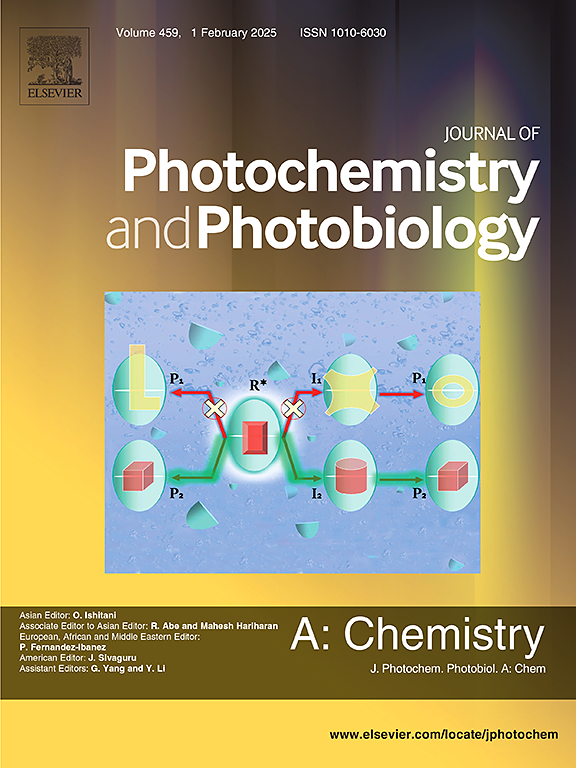Enhanced photocatalytic degradation of tetracycline by Mn,S co-doped TiO2 under visible-light irradiation
IF 4.1
3区 化学
Q2 CHEMISTRY, PHYSICAL
Journal of Photochemistry and Photobiology A-chemistry
Pub Date : 2025-04-02
DOI:10.1016/j.jphotochem.2025.116423
引用次数: 0
Abstract
To mitigate the accumulation of toxic materials in the environment, the development of efficient photocatalysts offers a sustainable approach to solar energy-assisted environmental remediation. TiO2-based photocatalysts are particularly attractive due to their favorable optical and electronic properties, low cost, and non-toxicity. In this study, Mn,S co-doped TiO2 materials with varying doping ratios were synthesized using the sol–gel method and characterized via XRD, XPS, UV–vis DRS, SEM, and BET. Mn,S co-doping effectively reduced the band gap of TiO2, enhancing light absorption. Specifically, the optimized 5%Mn-3%S-TiO2 exhibited the smallest band gap of 2.28 eV. When applied to the photocatalytic degradation of tetracycline hydrochloride (TC), it achieved a degradation rate of 67.03 % within 180 min, marking a 31.63 % improvement compared to undoped TiO2. These results underscore the potential of Mn,S co-doping to enhance the photocatalytic performance of TiO2, presenting a promising approach for environmental restoration through the efficient degradation of harmful pollutants.

可见光下Mn,S共掺杂TiO2增强四环素的光催化降解
为了减轻环境中有毒物质的积累,高效光催化剂的开发为太阳能辅助环境修复提供了一种可持续的方法。二氧化钛基光催化剂由于其良好的光学和电子性能、低成本和无毒性而特别具有吸引力。本研究采用溶胶-凝胶法合成了不同掺杂比例的Mn,S共掺杂TiO2材料,并通过XRD, XPS, UV-vis DRS, SEM和BET对其进行了表征。Mn,S共掺杂有效地减小了TiO2的带隙,增强了光吸收。其中,优化后的5%Mn-3%S-TiO2的带隙最小,为2.28 eV。将其应用于光催化降解盐酸四环素(TC)时,180 min内的降解率达到67.03%,比未掺杂的TiO2提高了31.63%。这些结果强调了Mn,S共掺杂增强TiO2光催化性能的潜力,为通过有效降解有害污染物来恢复环境提供了一种有希望的方法。
本文章由计算机程序翻译,如有差异,请以英文原文为准。
求助全文
约1分钟内获得全文
求助全文
来源期刊
CiteScore
7.90
自引率
7.00%
发文量
580
审稿时长
48 days
期刊介绍:
JPPA publishes the results of fundamental studies on all aspects of chemical phenomena induced by interactions between light and molecules/matter of all kinds.
All systems capable of being described at the molecular or integrated multimolecular level are appropriate for the journal. This includes all molecular chemical species as well as biomolecular, supramolecular, polymer and other macromolecular systems, as well as solid state photochemistry. In addition, the journal publishes studies of semiconductor and other photoactive organic and inorganic materials, photocatalysis (organic, inorganic, supramolecular and superconductor).
The scope includes condensed and gas phase photochemistry, as well as synchrotron radiation chemistry. A broad range of processes and techniques in photochemistry are covered such as light induced energy, electron and proton transfer; nonlinear photochemical behavior; mechanistic investigation of photochemical reactions and identification of the products of photochemical reactions; quantum yield determinations and measurements of rate constants for primary and secondary photochemical processes; steady-state and time-resolved emission, ultrafast spectroscopic methods, single molecule spectroscopy, time resolved X-ray diffraction, luminescence microscopy, and scattering spectroscopy applied to photochemistry. Papers in emerging and applied areas such as luminescent sensors, electroluminescence, solar energy conversion, atmospheric photochemistry, environmental remediation, and related photocatalytic chemistry are also welcome.

 求助内容:
求助内容: 应助结果提醒方式:
应助结果提醒方式:


